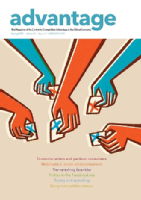The vanishing bus rider: What are the reasons for the great decline in bus ridership in the UK?
Margaret Thatcher is famously alleged to have said: “A man who, beyond the age of 26, finds himself on a bus can count himself as a failure.” Though the provenance of this remark remains in question, one thing is clear: each year there are fewer such “failing men” — and women, for that matter, writes Professor Mike Waterson from the University of Warwick’s Department of Economics, for an article first published in Advantage Magazine.
Bus travel per head is declining throughout Great Britain, even though, overall, people are travelling more. What are the reasons and what, if anything, should be done about it?
To an economist, one obvious question relates to prices. The price of travelling by bus has risen relative to consumer prices generally. Whilst the consumer price index (CPI) has risen 22 percent since the start of 2009, bus fares have risen on average by 39 percent. By contrast, the costs of operating a motor vehicle have risen roughly in line with inflation over the same period. So, bus fares have risen above the prime alternative. All things equal, this will lead to a drop in patronage.
Outside London, bus services are a mixture of commercial and supported services. The latter are services that local transport authorities view as socially necessary, but not commercially viable. Local authorities, looking for ways to make savings, have cut back on subsidies to such services, since their obligations are vague. Local authority-supported services outside London have halved in vehicle mileage since 2009, whereas commercial services have remained roughly unchanged. (These statistics, however, conceal a fall in commercial mileage in metropolitan areas and a rise outside.)
Costs rise, fares go up
Commercial services do receive some government money, mainly in the form of Bus Service Operating Grant, a declining rebate on fuel duty year on year, and payments for free concessionary travel, in lieu of payments that would be made by concession holders (allowing for the fact that not as many of these people would travel if they had to pay the fare). However, for the most part their income comes from fares. As their costs rise, fares will go up.
Herein lies the problem. Bus use is declining, so bus operating costs, which are largely independent of how many passengers they carry, fall ever more heavily on those who do use them. Buses tend to be used more intensely by people who do not have alternatives, and those who are on relatively low incomes, so there is a clear distributional issue. Rural services are differentially affected by cuts to subsidies, whilst urban and metropolitan services are affected more by declining patronage on commercial routes, as operators cut back in response. Clearly, this is a vicious circle.
Unusual model
To put it in context, Britain is unusual in the way bus services are supplied, at least within urban areas. The common European model is for the local authority to organise tenders for the supply of a given level of service and dictate (normally subsidised) fares. This system works well in countries such as Sweden and Germany. This approach is taken only in London within Britain, and the London system of tenders route by route has been admired in other countries. Indeed, London was, until recently, a shining example of growth amidst a sea of decline in patronage. Bus use, save for the last couple of years, has been increasing inside London and, in terms of journeys per person, London is a complete outlier still with over 250 per year.
It supplies over half of all bus journeys taken in England. Since 2017, six metropolitan areas outside London have been able to develop a similar system. Although none has yet taken this step, they may run into difficulties since the traditions are so different.
Here, interdependency over time is an issue with two facets. First, once services have been in the private sector, does a local transport authority have the right to remove commercial routes from operators and to put these routes out to tender? Second, even when significant competition emerges in the first round, companies that have secured a contract may believe that they will be best-placed to retain that contract in subsequent contests, potentially reducing competition down the line.
In London, by luck or good judgement, the market was initially separated among 13 different companies, each of which had a number of bus garages. Following some consolidation, seven major firms, plus some smaller companies, now operate there. Proximity between route and garage is a major factor influencing which firm operates which route, but there is continuing competition for the route-by-route tenders, since typically three or more firms’ garages are sufficiently close to the route to provide the service at reasonable cost. This suggests lessons for those metropolitan areas willing to consider introducing tendering.
Outside London
At the same time, the picture beyond London is not one of complete gloom. Areas with relatively high patronage outside London are, in order: Brighton and Hove, Nottingham and Reading, contrasting locations but all outside the major metropolitan areas. Notably, both Nottingham and Reading are amongst the small set of locations where the local authority provides most of the bus services within town, a model that was common prior to bus deregulation. Indeed, Reading is one of the few areas experiencing growth in patronage per head. Alongside Brighton, other major growth areas include Bath and Bristol. It seems that growing average affluence is not necessarily a barrier to growth in bus patronage.
Brighton provides an interesting example, with commercial operators competing with one another, a situation that is relatively unusual, since commonly, a single firm dominates. At the same time, Brighton has a good system that enables people to make use of different operators’ buses using the same payment card — a feature that is not often used in other “competitive" areas. Thus, Brighton passengers realise the benefits of such market competition that dissipate due to the lack of network interoperability elsewhere. In London, of course, interoperability is provided by Transport for London, the organiser of competition for the market, so the rider need have no knowledge of which operator actually runs a particular route. *
It might be said that discussion of buses, and the general picture of decline, is beside the point. With the growth of Uber and its rivals, people (at least, city travellers) can travel swiftly from where they are to where they want to go, at a price. However, there is a significant caveat, in the form of an unpriced externality. Uber, in setting the fare, takes into account that there may be congestion, but not the congestion that increased use of Uber actually creates. Even four cars, taking a total of eight passengers, will create more congestion than the bus which can take all eight. Thus, to some extent their growth exacerbates rather than negates the problem of what to do about buses, by slowing bus services as well as reducing patronage. Perhaps it is also time for some bold experiments, like that in Dunkirk, which has reduced bus fares to zero!
*Note that most rail competition also takes the form of competition for the market, not in the market.
Published:
17 April 2019
Author:
 Michael Waterson is professor of economics at the University of Warwick. He was also, from 2005 — 2014, a member of the UK Competition Commission, a body charged with examining the competition benefits of mergers, and certain market investigations. In particular, he was a member of the group which assessed competition in local buses (outside London) in 2010-11. More recently, he has been working on academic study of the London bus market.
Michael Waterson is professor of economics at the University of Warwick. He was also, from 2005 — 2014, a member of the UK Competition Commission, a body charged with examining the competition benefits of mergers, and certain market investigations. In particular, he was a member of the group which assessed competition in local buses (outside London) in 2010-11. More recently, he has been working on academic study of the London bus market.
Advantage Magazine:
This article first appeared in the Spring 2019 edition of Advantage, the magazine of the ESRC-funded Centre for Competitive Advantage in the Global Economy.
Click on the image to see the latest issue of Advantage.


